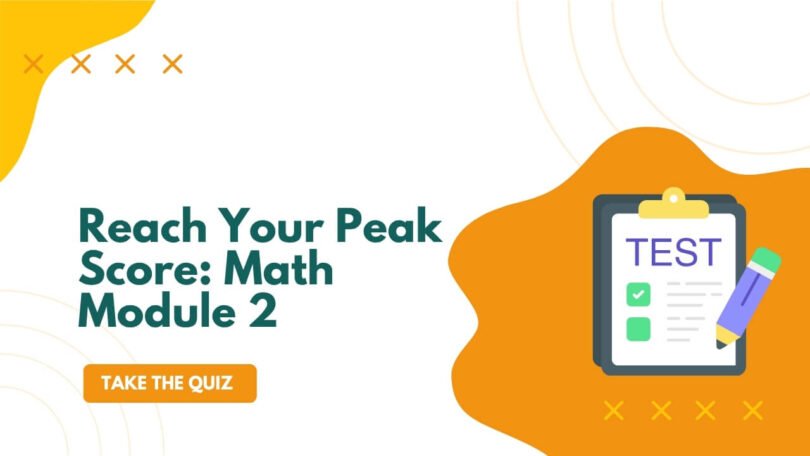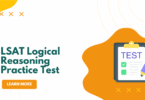The SAT Math Module 2 is where top scores are made. This adaptive section adjusts to your performance on Module 1, presenting you with more complex problems that require deeper critical thinking and advanced problem-solving skills. Whether you’re aiming for a good score or a great one, mastering this 22-question, 35-minute module is non-negotiable.
Our SAT Math Module 2 Practice Quiz is specifically designed to simulate this higher-stakes environment. Here, you’ll face challenging questions that integrate concepts from multiple areas of math. Expect to see advanced algebra, complex geometric figures, and multi-step data analysis problems that require careful interpretation. This is your chance to practice applying your knowledge under pressure and tackling the types of questions that separate a good score from an elite one.
Use this quiz to push your abilities, refine your strategies for difficult problems, and ensure you’re prepared for the most challenging material the SAT has to offer. Prove you’re ready to earn a top SAT math score.
This is a timed quiz. You will be given 2100 seconds to answer all questions. Are you ready?
In the equation y = 15(1.05)^x, what does the number 1.05 represent?
In an exponential growth model y = a(b)^x, 'b' is the growth factor. A factor of 1.05 means a 5% increase each period (1 + 0.05).
What is the sum of the solutions to the equation (x - 6)(x + 0.7) = 0?
The solutions are the values of x that make each factor zero. So, x - 6 = 0 gives x = 6, and x + 0.7 = 0 gives x = -0.7. The sum is 6 + (-0.7) = 5.3.
A circle in the xy-plane has its center at (2, -3) and a radius of 4. What is the equation of the circle?
The standard equation of a circle is (x - h)² + (y - k)² = r², where (h, k) is the center and r is the radius. Plugging in the values gives (x - 2)² + (y - (-3))² = 4², which simplifies to (x - 2)² + (y + 3)² = 16.
(Student-Produced Response) In the right triangle ABC, if the length of leg AC is 8 and the length of the hypotenuse AB is 17, what is the length of leg BC?
Using the Pythagorean theorem a² + b² = c²: 8² + (BC)² = 17². This gives 64 + (BC)² = 289. So, (BC)² = 289 - 64 = 225. The length of BC is the square root of 225, which is 15.
A bag contains 5 red, 4 blue, and 3 green marbles. If one marble is drawn at random, what is the probability that the marble is NOT blue?
There are a total of 5 + 4 + 3 = 12 marbles. The number of marbles that are not blue is 5 (red) + 3 (green) = 8. The probability is 8/12, which simplifies to 2/3.
If x > 0 and 2x² + 5x - 12 = 0, what is the value of x?
This quadratic equation can be factored into (2x - 3)(x + 4) = 0. The solutions are x = 3/2 and x = -4. Since the question states x > 0, the correct value is 3/2.
(Student-Produced Response) If y = 2x and x + y = 9, what is the value of y?
Substitute y = 2x into the second equation: x + (2x) = 9, which gives 3x = 9, so x = 3. Now find y using the first equation: y = 2(3) = 6.
For the imaginary number i, which of the following is equivalent to (2 + 3i) - (1 - 5i)?
Distribute the negative and combine like terms: (2 - 1) + (3i - (-5i)) = 1 + (3i + 5i) = 1 + 8i.
If x - 3 is a factor of the polynomial p(x) = x² - kx + 6, what is the value of k?
According to the Factor Theorem, if x - 3 is a factor, then p(3) must equal 0. So, (3)² - k(3) + 6 = 0. This gives 9 - 3k + 6 = 0, or 15 - 3k = 0. Solving for k, we get 3k = 15, so k = 5.
(Student-Produced Response) What is the positive solution to the equation |2x - 3| = 7?
We solve two separate equations: 2x - 3 = 7 and 2x - 3 = -7. The first gives 2x = 10, so x = 5. The second gives 2x = -4, so x = -2. The positive solution is 5.
The population of a town, P = 10000(0.98)^t. What is the best interpretation of the number 0.98?
In an exponential decay model, the base (0.98) represents 1 minus the decay rate. So, 1 - r = 0.98, which means the decay rate r is 0.02, or a 2% decrease each year.
A cylinder has a radius of 3 and a height of 5. A cone has the same radius and height. What is the volume of the cylinder minus the volume of the cone?
Volume of cylinder = πr²h = π(3²)(5) = 45π. Volume of cone = (1/3)πr²h = (1/3)(45π) = 15π. The difference is 45π - 15π = 30π.
If √(3x - 5) = 5, what is the value of x?
Square both sides of the equation to get 3x - 5 = 5². This simplifies to 3x - 5 = 25. Add 5 to both sides: 3x = 30. Divide by 3: x = 10.
(Student-Produced Response) If y >= 2x + 1 and y > (1/2)x - 1, which quadrant contains no solutions? (Enter 1, 2, 3, or 4)
The solution area is above both lines. This shaded region covers parts of Quadrant I, Quadrant II, and Quadrant III. There are no solutions in Quadrant IV.
Two datasets have the same mean. Dataset A has a standard deviation of 2.5 and Dataset B has 5. Which statement is true?
Standard deviation measures the spread of data around the mean. A larger standard deviation (like in Dataset B) means the data points are, on average, more spread out.
If the graph of y = f(x) is shifted 2 units up, what is the new equation?
A vertical shift up by 'c' units is represented by adding 'c' to the function. Therefore, the new equation is y = f(x) + 2.
An angle measures 5π/6 radians. What is its measure in degrees?
To convert radians to degrees, multiply by 180/π. So, (5π/6) * (180/π) = (5 * 180) / 6 = 900 / 6 = 150 degrees.
(Student-Produced Response) In ax - 5 = 3x + b, if the equation has no solution, what is the value of a?
For a linear equation to have no solution, the coefficients of x must be equal, but the constants must be different. Therefore, a must be equal to 3.
A rectangular field is enclosed with 200 feet of fencing. What is the maximum possible area of the field, in square feet?
For a fixed perimeter, a square will always maximize the area. A square with a perimeter of 200 feet has four sides of length 200/4 = 50 feet. The area is 50 * 50 = 2500 square feet.
A model uses a scale of 1 inch to 12 feet. If a room in the model has an area of 10 square inches, what is the actual area in square feet?
The scale for area is (1 inch)² to (12 feet)², which is 1 square inch to 144 square feet. Therefore, 10 square inches corresponds to 10 * 144 = 1440 square feet.
A survey of 1,000 people has a margin of error of +/- 3 percentage points. If 55% of respondents preferred coffee, which is a plausible value for the actual percentage?
The plausible range is from 55% - 3% to 55% + 3%, which is 52% to 58%. Of the choices, only 57% falls within this range.
In a square with side 8, a circle with radius 4 is inscribed. What is the area of the region inside the square but outside the circle?
Area of the square is side² = 8² = 64. Area of the inscribed circle is πr² = π(4)² = 16π. The shaded area is the difference: 64 - 16π.
Share your Results:







